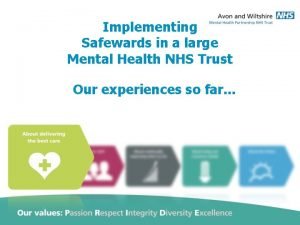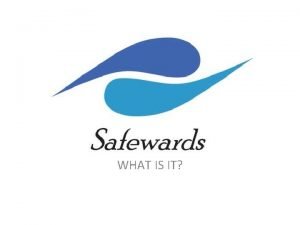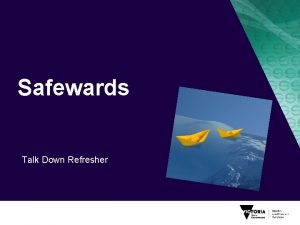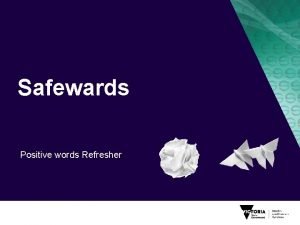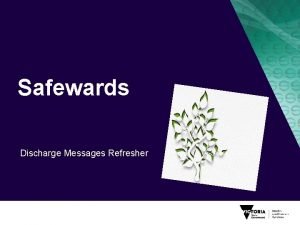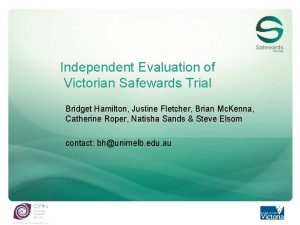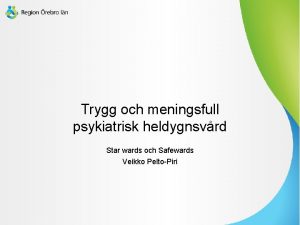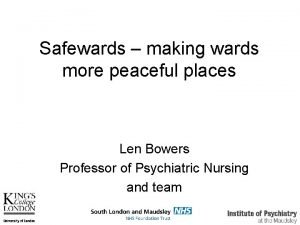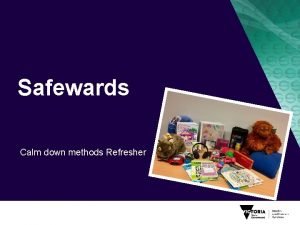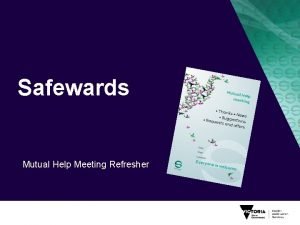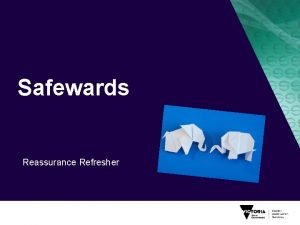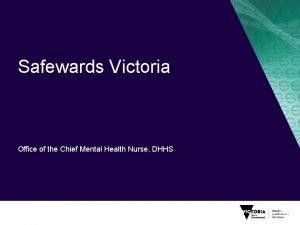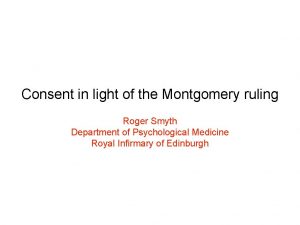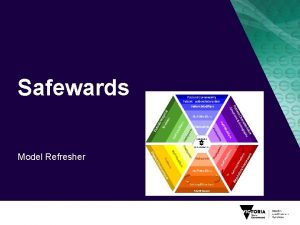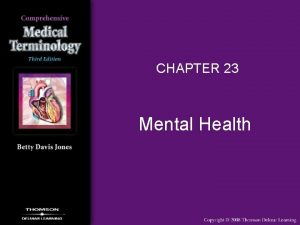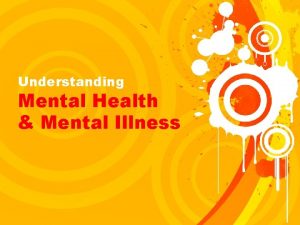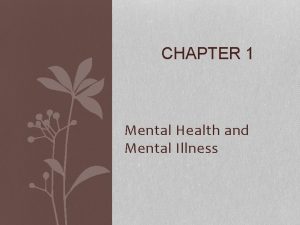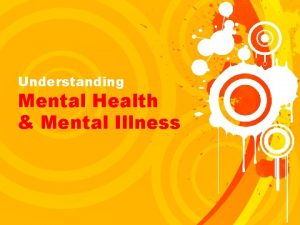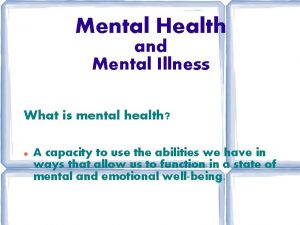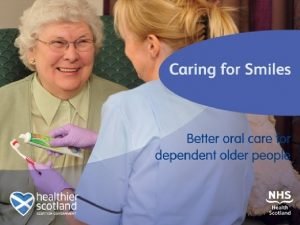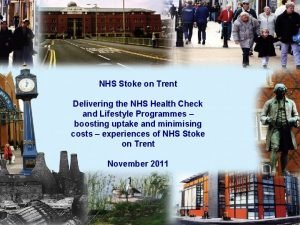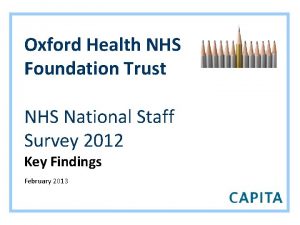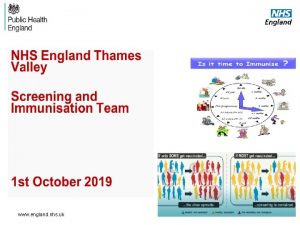Implementing Safewards in a large Mental Health NHS



























- Slides: 27

Implementing Safewards in a large Mental Health NHS Trust Our experiences so far. . .

Introductions Mark Earl Safewards Involvement Champion Andy Mott Violence Reduction Nurse

Overview • Safewards is a model for reducing incidents of conflict and containment on mental health in-patients wards. • The model is evidence–based (Bowers et al. , 2013) and has been subject to a randomised controlled study. http: //www. safewards. net/ • The Safewards trial reduced conflict on wards by 14. 6 per cent and containment activity decreased by 23. 6 per cent.

Violence reduction • 2 year plan 2014/2016 to roll out Safewards to all in-patient services in AWP • Supported by the Trust Executive board • 40 in-patient wards signed up • ‘Safewards Community of Practice’ to support champions and local focus groups. • Part of Trust Violence Reduction Plan for reducing restrictive practices. • Keeping ward staff and service users safe • Contacts Mark. Earl 1@nhs. net or Amott@nhs. net

Implementation challenges • Partnership working between staff and service users • Champions networking – Trust wide group, local groups with local focus • Achieving ‘Buy in’ from managers, staff and other disciplines • Leadership and ownership

The 10 interventions • • • Soft Words Discharge Messages Positive Words Calm Down Methods Clear Mutual Expectations Mutual Help Meeting Know Each Other Talk Down Bad News Mitigation Reassurance

Soft words Encouraging Motivating Supportive Reasoning Collaborative Working

When does Soft Words occur? The soft words intervention is for use by ward staff to set limits, standards and expectations with the service users they are caring for. Acutely unwell people can be difficult to manage, and it is part of the nursing staff role to ensure they look after themselves, are kept safe and comply with medication, treatment, and engage within the ward routine. Soft Words tips • • • Avoid saying an unqualified ‘No’ Sympathise Attend and listen Yes is best! Identify with the patient Never forget a promise or request Give good reasons why, or why not We’re not always right Provide options and choices

Discharge Messages Hope Tree/Discharge Messages This intervention aims to create a legacy of hope and inspiration for service users as they access care on the ward and then with hope, move on to rehabilitation or back home again. This is very much recovery orientated, and sharing the positive things which have happened for service users. With the creation of a colourful mural, often made by service users, it enables them to reflect and post on their care journey, and make a positive contribution for others just starting. We acknowledge that on some wards service users are detained for an extended time, and for this reason we have included the term a ‘Hope Tree’ for service users to post on.

Positive words Thoughtful Non-judgemental Understanding Aware Sensitive

When does positive words occur? Positive words is intended for use by staff during handover. When describing a service user’s challenging behaviour during a shift, using negative language instead of finding something positive to say, it can create an ongoing expectation that the service user has no redeeming qualities. Using Positive Words serves to humanise the person, and it also keeps up a positive expectation with staff, encouraging the best rather than expecting the worst. Being mindful of our spoken communication, will also serve to keep us safe as ward staff. It helps to create boundaries and mutual respect and asserting that we always seek the best interest of our service user.

Calm Down Methods When we are at home and we are feeling stressed or anxious we tend to have items around us which we like and enjoy and which serve to help calm us down and make us feel better. When a service user is detained on a ward they have no access to such belongings. Safewards funds have allotted a budget for each ward to identify and spend on calming items requested by service users. This has resulted in a broad variety of items being accessible on wards, from MP 3 players, to adult colouring, soft toys and blankets, appropriate games and baseball kit, and soothing lights, aromas and meditation CDs.

Clear Mutual Expectations It’s important for staff and service users to know where they stand in relation to each other, and how to keep safe within the ward community. Clear mutual expectations are being carried out across our wards, whereby we talk with staff and especially service users to establish what they expect from each other. This means expectations are owned by the ward, and when formalised and placed in a visual format on the ward can be referred to when ever there is contention between staff and service user expectations.

Clear Mutual Expectations 1. We expect to actively participate in the Safewards Community of Practice in a warm and friendly atmosphere. 2. We agree to give each other professional support in an inclusive, non-threatening environment where personal growth can occur. 3. We agree to acknowledge our unique differences i. e. , who we are, where we work, the experience we bring to the group. 4. We agree to respect our individual opinions. 5. We acknowledge the importance of feeling comfortable enough to share our honest experiences. 6. We agree not to be critically judgemental of each other. If we should need to challenge practices and behaviour within the group that is not reflective of the Safewards philosophy, we will use the principles of ‘Talk down’, ‘soft words’, ‘reassurance’, ‘bad news mitigation’. 7. We agree to be the ambassadors for Safewards in AWP and as such will demonstrate positive role-modelling with the aim of embedding the philosophy into the culture of the organisation.

Mutual Help is aimed at using the dynamic of the service user community as peer support. It is quite a simple intervention to implement, and if wards are able to run it at least twice a week it can become a useful part of the ward routine. We ask that service users at the meeting acknowledge each other, and request and offer support and help to each other for the day ahead. This creates validation and self-worth and respect between service users, making the best of the community, and the individuals as part of the community.

Know each other

Talk Down Aware Listening Genuine Modelling Calm

When does Talk Down occur? When a service user is very aroused, confrontational and even physically aggressive this should be managed carefully and skilfully using verbal communication. Managing such a situation well requires experience, but we can all learn from each other. When a crisis point arises where it seems likely that a service user might become violent or harm themselves and others, it is often possible to talk to them to help them calm down This is the essence of Safewards, where we seek to avoid physical restraint, coerced medication or seclusion by always aiming to keep the channels of communication open between staff and service users.

Reassurance Understanding Being Present Community Support and Involvement Checking in Remembering

When does Reassurance occur? This intervention takes place after a significant incident on the ward. Serious interventions to acts of absconding, violence, extremely unwell people or arguments such as manual restraint or coerced medication can impact on everyone on the ward. It looks to speak with and support all service users who were witness to the disruptive incident, to make sure they are Ok and are not left feeling scared or unsupported. Staff on the ward should also be able to support and reassure each other as a means to keeping safe and supported.

Bad News Mitigation Open Aware Open Listening Sensitive Caring

When does bad news occur? From within the ward; leave not granted, change in medication, longer stay on the ward than anticipated From outside the ward; loss of job or home, relationship breakdown, bereavement Bad news mitigation should anticipate the reaction or over reaction of the service user. Think carefully about choice of words, and environment and context. Don’t patronise: ‘never mind you can have some leave next week. ’ Don’t try to soften the news by underplaying its significance.

Clinical toolkit

Coaching and awareness • • • Team building Support and improve morale, taking care of ourselves Role Modelling and Shaping practice Invigorating Establish dialogue and positive working relationships Person centred - commitment to service users Community of practice Engaging in therapeutic care Embed into stat/man training

Changing Corporate and Clinical culture • Safewards philosophy supports the existing Trust values • Promotes open and transparent practice • Reinforces professional responsibility and accountability • Should improve job satisfaction • Improve the recovery experience for service users • WIN/WIN

Managing resistance • Identify root cause(s), there can be many • Demonstrate understanding • Model the interventions i. e. , soft words, positive words etc • Focus on strengths and celebrate small steps • Emphasise the benefits with examples • Encourage networking • Share service user success stories

Questions ?
 Soft words safewards
Soft words safewards Mental health and mental illness chapter 20
Mental health and mental illness chapter 20 Jeopardy mental health
Jeopardy mental health Safewards posters
Safewards posters Safewards talk down
Safewards talk down Positive words safewards
Positive words safewards Discharge messages safewards
Discharge messages safewards Safewards 10 interventions
Safewards 10 interventions Safewards sverige
Safewards sverige Len bowers safewards
Len bowers safewards Safewards talk down
Safewards talk down Mutual help meeting
Mutual help meeting Len bowers safewards
Len bowers safewards Safewards positive words
Safewards positive words Tasmin v barts health nhs trust
Tasmin v barts health nhs trust Hrd program implementation and evaluation
Hrd program implementation and evaluation Management issues central to strategy implementation
Management issues central to strategy implementation Mis issues in strategy implementation
Mis issues in strategy implementation Chapter 7 strategic management
Chapter 7 strategic management Tripod pricing strategy
Tripod pricing strategy Implementing merchandise plans
Implementing merchandise plans Designing and implementing brand marketing programs
Designing and implementing brand marketing programs Designing and implementing brand architecture strategies
Designing and implementing brand architecture strategies What is documentation portfolio
What is documentation portfolio Crm vision statement example
Crm vision statement example Qsen teamwork and collaboration definition
Qsen teamwork and collaboration definition Challenges of implementing predictive analytics
Challenges of implementing predictive analytics Implementing organizational change spector
Implementing organizational change spector
